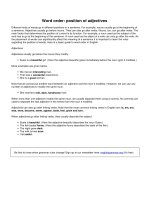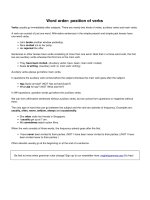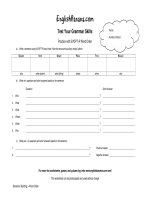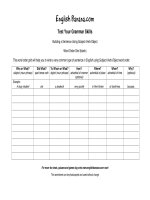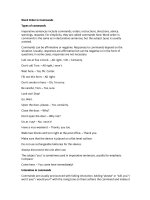UEfAP word order
Bạn đang xem bản rút gọn của tài liệu. Xem và tải ngay bản đầy đủ của tài liệu tại đây (109.76 KB, 2 trang )
25/2/2016
UEfAP Word Order
UEfAP Word Order
Introduction
Syntax
Syntax is a traditional term for the study of the rules governing the way words are combined to
form groups, clauses and sentences in a language. In contrasts with morphology, which studies the
structure of words.
The main syntactic elements of clauses are: Subject, Predicator, Complement (Direct Object, Indirect
Object, Subject Complement, Object Complement) andAdjunct.
Clauses are made up of groups, which are made up of words. Words combine to form groups.
Therefore, a group consists of one or more words; it can be thought of as an expanded word. A typical
structure of a group would be mhq modifier, head, qualifier. Groups combine to form clauses. Typical
groups are nominal groups, verbal groups, adjectival groups, adverbial groups.
Syntax studies the rules of these combinations.
For example, in a setence such as:
Neural connections between the suprachiasmatic nuclei (SCN) and most other regions of the brain
have been cut and yet the SCN has continued to be rhythmic.
we may be interested in how the words combine to form a meaningful sentence. This is syntax.
However we might also be interested in how the words "connections, continued, rhythmic" can be
divided into parts: "connect + ion + s", "continued + d" and "rhythm + ic", or how "suprachiasmatic" is
formed. This is morphology.
Exercises
Try these exercises: Syntax Exercises
Many syntactical mistakes are simply avoided by proofreading.
Whenever you learn a new word, it is useful to learn typical situations in which it occurs. You need to
know in which subjects it is used, what kinds of texts it is used in, and which other words it typically
occurs with. Look at the example sentences in your dictionary and find examples of the uses of the
word in your textbooks.
You can use the Internet to help you with this. Type any word or phrase use "quotation marks" to
search for a phrase into a search engine and examine the results. You will often find hundreds of
examples of the use of the word or phrase. You need to look at the examples carefully to see what
/>
1/2
25/2/2016
UEfAP Word Order
kind of writing they are from. There are, though, many examples of academic, business and
government texts on the Internet and examples from these sources should be useful.
The Grammar Safari or WebCorp websites will help you with this.
Try these exercises.
/>
2/2




